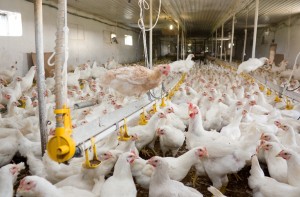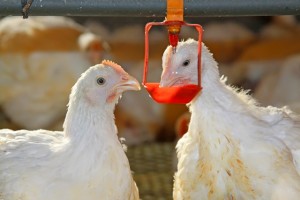Poultry Diseases
Ascites
Also known as: Duodenal Dropsy

Ascites is a disease associated with intensive broiler production. Management plays a key role in its development, with feed, lighting, air quality and ventilation all having been implicated
This condition is most commonly seen in fast growing broiler systems (Julian, 1998), so should not be a problem in organic and extensive free range systems that are using suitable breeds. Ascites syndrome in broilers is a cascade of events that result in cardiac anomalies, including an enlarged, flaccid heart, and right ventricular hypertrophy, that leads to an accumulation of fluid in the abdominal cavity (Balog, 2003). Although the disease is not fully understood, heart failure is thought to be a consequence of a lowered oxygen tension in poultry houses and birds suffering from too little oxygen. Poor ventilation is a major contributory factor.
There are four general categories of dysfunctions that will result in ascites fluid build-up (Balog, 2003):
- Vascular damage that allows capillaries to leak
- Blockage of the lymphatic system that prevents drainage
- Decreased plasma oncotic pressure
- The most frequently seen dysfunction, increased vascular hydraulic pressure
Increased vascular hydraulic pressure can be caused by several types of pathologies, including hepatic, cardiac or right atrioventricular, and the most significant, pulmonary hypertension. Pulmonary hypertension accounts for most cases of ascites seen in commercial broilers. The hypertension can originate from many different causes (Balog, 2003); environmental causes such as altitude, cold stress and incubator environment, will all affect the incidence of ascites.
The first signs for the poultry keeper are the obvious fluid in the abdominal cavity – affected birds will have a hugely distended abdomen.
When the disease was first observed, it was seen mainly in areas of higher altitude and in fast growing broilers (Mirsalimi et al, 1993), although it now occurs at all altitudes. Management plays a significant role in ascites development, with anything that could stress and put a strain on the bird’s heart being a potential contributory factor. With feed, lighting, air quality and ventilation all having been implicated in ascites development. Growth rate, oxygen requirements, organ size and capacity, haematological parameters and cellular responses can all determine how resistant or susceptible a broiler is to ascites. Cold temperatures, coupled with high energy diets, can result in ascites-related deaths as a consequence of insufficient blood vessel capacity in the lungs for the blood flow necessary to meet a high metabolic oxygen requirement (Julian et al, 1989).
The reduced intensity of feeding in organic and extensive, outdoor-reared poultry should reduce the risk of ascites, and a detailed review of the causes, clinical signs and control of ascites is provided by Julian (1990).
Control and Prevention of Ascites

Sodium levels in feed should not exceed 0.2%, and particular care should be taken when sodium occurs at high levels in the water supply. Water with sodium levels higher than 0.1% should not be given to young table birds
Ascites caused by hypertension is associated with high levels of feeding and rapid growth, and is therefore more allied with intensive production. Ascites should not be a serious problem in free-range and extensive table bird production systems, where the emphasis is on slower growth rates, although birds kept outdoors in hot and humid climates may be put under strain and could be affected.
Keeping poultry at high altitudes is not advisable. If poultry are kept under these conditions, environmental temperature, humidity and air movement should be controlled during cold periods, so as to avoid an excessive loss in body temperature.
In addition, other contributory factors should be considered in preventing this condition. Sodium levels in feeds should not exceed 0.2% and care should be taken in feeding sodium when this occurs at high levels in the water supply; water containing more than 0.1% sodium should not be used for young table birds. Although sodium chloride in water is an important source of sodium, other sources should also be considered.
There is potential for selection of ascites resistant lines of broilers (Balog, 2003).
Treating Ascites
Although individual affected birds cannot be effectively treated, flax oil may be an effective method of reducing ascites and pulmonary hypertension in the flock, without affecting performance. A diet high in n-3 and n-6 polyunsaturated fatty acids, such as flax oil, may slow down the development of ascites, due to the release of endogenous coronary relaxants and attenuated inflammatory compounds. (Bond et al, 1996). If ascites is seen, the management of the flock needs to be changed – for example ventilation needs to be improved in order to reduce humidity and therefore strain on the heart.
Good Practice Based on Current Knowledge
- Focus on slower growth rates and avoid feeding high energy diets
- Use breeds/strains that have not been selected for rapid growth
- Do not use drinking water with a high salt content
- Avoid feeds with a high salt content
- Provide table birds kept at high altitudes with well-insulated housing


 American English
American English

Comments are closed.